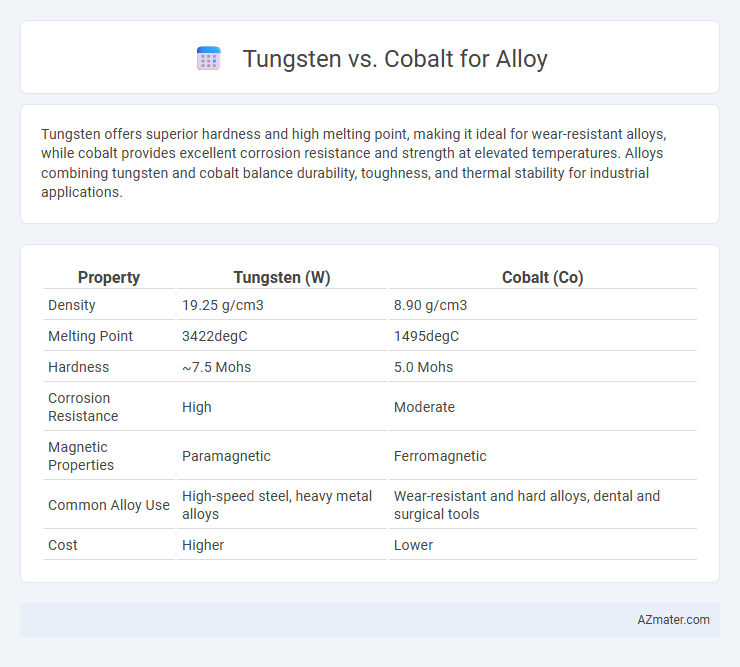Tungsten offers superior hardness and high melting point, making it ideal for wear-resistant alloys, while cobalt provides excellent corrosion resistance and strength at elevated temperatures. Alloys combining tungsten and cobalt balance durability, toughness, and thermal stability for industrial applications.
Table of Comparison
| Property | Tungsten (W) | Cobalt (Co) |
|---|---|---|
| Density | 19.25 g/cm3 | 8.90 g/cm3 |
| Melting Point | 3422degC | 1495degC |
| Hardness | ~7.5 Mohs | 5.0 Mohs |
| Corrosion Resistance | High | Moderate |
| Magnetic Properties | Paramagnetic | Ferromagnetic |
| Common Alloy Use | High-speed steel, heavy metal alloys | Wear-resistant and hard alloys, dental and surgical tools |
| Cost | Higher | Lower |
Introduction to Tungsten and Cobalt Alloys
Tungsten alloys are renowned for their exceptional density, high melting point above 3422degC, and excellent wear resistance, making them ideal for applications requiring strength and heat endurance. Cobalt alloys, characterized by superior corrosion resistance, magnetic properties, and good thermal stability, are widely used in medical implants, aerospace, and cutting tools. Comparing tungsten and cobalt alloys highlights their distinct advantages, with tungsten providing unmatched hardness and cobalt offering enhanced toughness and biocompatibility.
Chemical and Physical Properties Comparison
Tungsten exhibits a higher melting point of 3422degC and exceptional hardness, making it ideal for applications requiring extreme heat resistance and durability. Cobalt, with a melting point of 1495degC, offers superior toughness and corrosion resistance, contributing to alloy strength and flexibility. Chemically, tungsten is inert against oxidation up to 500degC, while cobalt forms stable oxides that enhance wear resistance and magnetic properties in alloys.
Common Applications of Tungsten Alloys
Tungsten alloys are extensively used in aerospace components, military armor-piercing ammunition, and radiation shielding due to tungsten's high density and melting point. Unlike cobalt, which is typically favored in high-strength, wear-resistant applications like cutting tools and superalloys, tungsten alloys excel in environments requiring exceptional hardness and thermal stability. These properties make tungsten alloys indispensable in heavy-duty industrial applications, including electrical contacts, vibration dampers, and medical devices such as X-ray targets.
Typical Uses for Cobalt Alloys
Cobalt alloys are predominantly used in aerospace, medical implants, and cutting tools due to their exceptional wear resistance, high-temperature strength, and corrosion resistance. These alloys excel in turbine blades, artificial joints, and dental prosthetics where durability and biocompatibility are critical. Compared to tungsten alloys, cobalt alloys offer superior toughness and thermal stability, making them ideal for demanding industrial applications.
Strength and Durability Differences
Tungsten alloys exhibit superior strength and wear resistance due to their high melting point and density, making them ideal for applications requiring extreme durability. Cobalt alloys offer excellent toughness and thermal stability but generally have lower hardness compared to tungsten, resulting in less wear resistance under high-stress conditions. The choice between tungsten and cobalt alloys depends on whether maximum hardness or enhanced toughness is prioritized in the specific industrial application.
Heat and Corrosion Resistance
Tungsten alloys exhibit superior heat resistance, maintaining strength and structural integrity at temperatures exceeding 3400degC, making them ideal for high-temperature applications. Cobalt alloys provide excellent corrosion resistance, particularly in harsh chemical environments, due to the formation of a stable oxide layer that protects against oxidation and wear. Combining tungsten's thermal stability with cobalt's corrosion resistance results in alloys suitable for aerospace and industrial tooling where both extreme heat and corrosive exposure are prevalent.
Cost and Availability Factors
Tungsten alloys typically have higher costs due to the scarcity of tungsten ore and complex extraction processes, making them less readily available than cobalt alloys. Cobalt alloys benefit from more established mining operations and a more stable supply chain, which generally results in lower material cost and greater availability. Cost efficiency in alloy production often favors cobalt, especially in large-scale industrial applications where consistent supply is critical.
Environmental Impact and Sustainability
Tungsten and cobalt alloys differ significantly in environmental impact and sustainability; tungsten mining involves high energy consumption and generates considerable waste, but tungsten's longer tool life enhances resource efficiency. Cobalt sourcing raises critical ethical concerns due to cobalt mining's association with human rights issues and environmental degradation, while recycling programs improve cobalt alloy sustainability. Selecting alloys requires balancing tungsten's durability against cobalt's supply chain challenges to optimize environmental outcomes.
Machinability and Manufacturing Considerations
Tungsten alloys offer exceptional hardness and wear resistance but present challenges in machinability due to their high melting point and brittleness, requiring specialized cutting tools and slower machining speeds. Cobalt alloys provide better machinability with improved ductility and toughness, allowing for easier shaping and less tool wear during manufacturing processes. Selecting between tungsten and cobalt for alloys depends on balancing the need for durability against manufacturing efficiency and tool compatibility.
Choosing the Right Alloy for Your Application
Tungsten alloys offer exceptional hardness, high melting points, and excellent wear resistance, making them ideal for applications requiring durability and heat resistance, such as aerospace and cutting tools. Cobalt alloys provide superior toughness, corrosion resistance, and magnetic properties, suited for medical implants, hard-facing, and high-speed steel production. Selecting the right alloy depends on factors like mechanical stress, environmental exposure, and thermal requirements specific to your application.

Infographic: Tungsten vs Cobalt for Alloy
 azmater.com
azmater.com